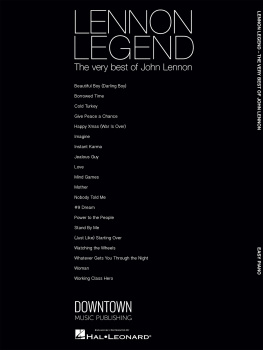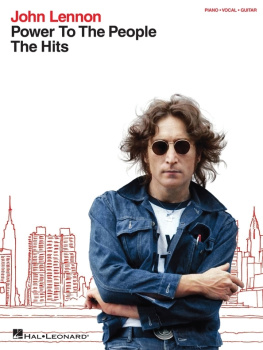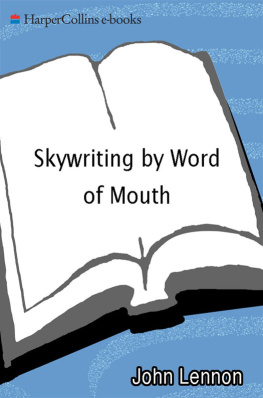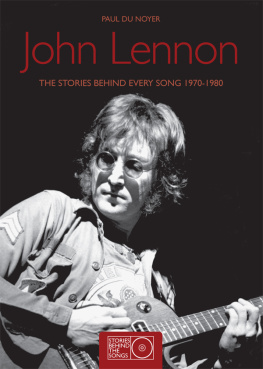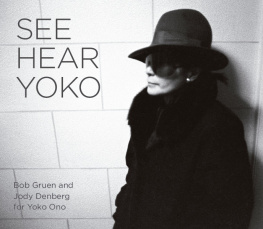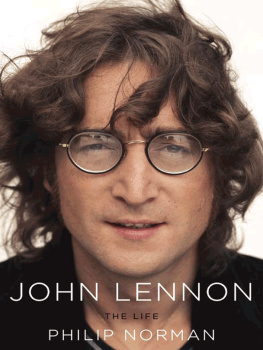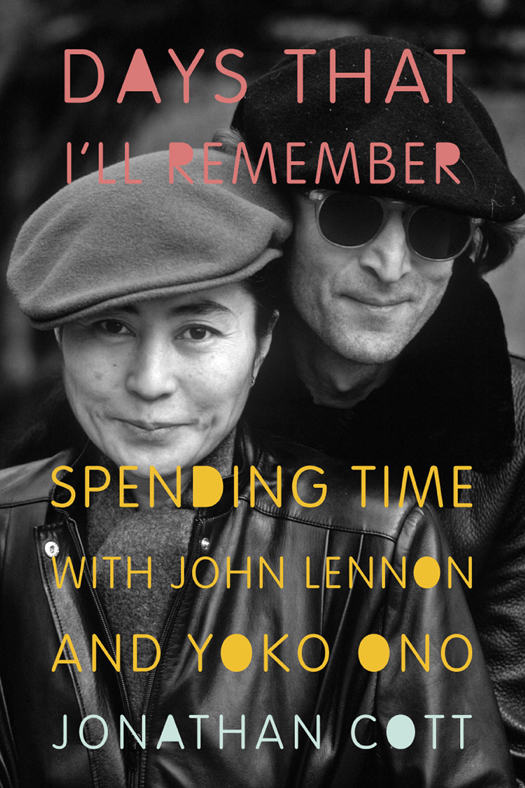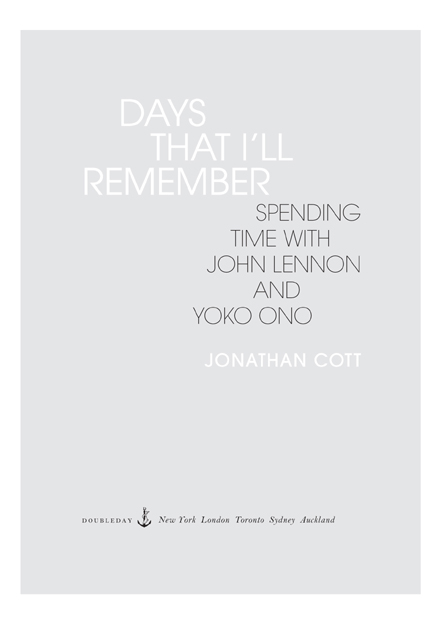
()
Copyright 2013 by Jonathan Cott
All rights reserved. Published in the United States by Doubleday, a division of Random House, Inc., New York, and in Canada by Random House of Canada Limited, Toronto.
www.doubleday.com
DOUBLEDAY and the portrayal of an anchor with a dolphin are registered trademarks of Random House, Inc.
Grateful acknowledgment is made to Yoko Ono for permission to reprint previously published and unpublished material from interviews between the author and John Lennon and Yoko Ono, portions of which originally appeared in different form in Rolling Stone magazine on November 23, 1968, March 18, 1971, and December 23, 2010.
Jacket design by Emily Mahon
Jacket photograph Allan Tannenbaum
LIBRARY OF CONGRESS CATALOGING-IN-PUBLICATION DATA
Cott, Jonathan.
Days that Ill remember : spending time with John Lennon and Yoko Ono / Jonathan Cott.
p. cm.
1. Lennon, John, 19401980Interviews. 2. Ono, YokoInterviews. 3. Rock musiciansInterviews. I. Title.
ML420.L38C68 2013
782.421660922dc23
[B]
2012025355
eISBN: 978-0-385-53638-7
v3.1
Contents
We were a wizard and a witch
In a moment of freedom.
YOKO ONO, YOU RE THE ONE
AUTHORS NOTE
In Days That Ill Remember, I am presenting for the first time the complete versions of all of my significant interviews and conversations with John Lennon and Yoko Ono; all of them contain new and previously unpublished material.
I first met and interviewed John in September 1968 in London; it was the first extensive interview he gave after he and Yoko had become lovers and collaborators four months earlier. A shorter version of this conversation appeared in Rolling Stone magazines first anniversary issue, dated November 23, 1968.
John once told me: Yoko is the most famous unknown artist. Everybody knows her name, but nobody knows what she does; and in 1970, with his encouragement and participation, I wrote one of the first extensive profiles of Yoko, a shortened version of which appeared in the March 18, 1971, issue of Rolling Stone. The complete version of that profile appears here for the first time.
When John and Yoko moved permanently to New York City in the early 1970s, I would run into them at odd times and places, and the three of us would occasionally meet up for dinner. In this book I am including an account of one of the most unusual and lively of our dinner conversations that took place on March 17, 1971.
I saw and interviewed John on December 5, 1980, three days before his death. It was his last print interview, and most of our nine-hour conversation appeared for the first time in the December 23, 2010, issue of Rolling Stone. A greatly expanded, and now complete, version of that interview is included here.
On March 14, 2012, I interviewed Yoko in Stockholm, Sweden, especially for this book; this is the first publication of that interview.
In Days That Ill Remember, I have incorporated several brief passages from my essay John Lennon: How He Became Who He Was, which first appeared in an anthology I co-edited entitled The Ballad of John and Yoko, published by Doubleday in 1982; as well as from my essay Children of Paradise: Back to Where We Once Belonged, which appeared in Rolling Stones tenth anniversary issue in 1977.
INTRODUCTION
Is there anybody going to listen to my story / All about the girl who came to stay? John Lennon asked in his song Girl on the Beatles 1965 Rubber Soul album. Three years later, on the afternoon of September 17, 1968, I found myself ringing the doorbell of a basement flat at 34 Montagu Square in London. After a few seconds, an effervescent twenty-seven-year-old man with shoulder-length dark-brown hairdressed in a black sweater, jeans, and white tennis shoes and wearing round, wire-rimmed granny glassesopened the door. Come in, come in! he said, then led me into the living room where he introduced me to the extraordinary girl who had come to stay, invited me to sit down on a couch, and asked me if I would like to listen to his story.
Days That Ill Remember is my own personal story about the times that I spent with John Lennon and Yoko Ono over a period of forty-five years. It is a story that began on a cold New York City morning in December 1963 during the first semester of my senior year at Columbia College. My clock radio had woken me up at 7:30. Craving another few minutes of sleepeven if it meant that I would arrive late for my much-dreaded class in set theoryI decided to turn the radio off, but just as my hand was reaching for the knob, I suddenly heard a male voice shouting out One-Two-Three-FAW! And then: She was just seventeen / If you know what I mean! Just as it happens in the song, my heart went BOOM, and I immediately knew that, from that moment on, I Saw Her Standing There would be the wake-up call for my entire life.
I cant wake you up, John Lennon once said. You can wake you up. But, luckily, the Beatles were going to remind me to do soWoke up, fell out of bed / Dragged a comb across my head. Sometimes, however, it seemed as if the Beatles themselves were a dream from which you really never wanted to awake. In fact, many people came to think of the four Beatles as symbolic dream figures and presenceslike the four evangelists, the four seasons, the four phases of the moon, the four corners of the earthand in an elementary sense, each Beatle, in the way he became defined by his face, gestures, voice, and songs, took on an archetypal role: Paul, sweet and sensitive; John, restless and rebellious; George, mysterious and mystical; Ringo, childlike but commonsensical.
None of us wouldve made it alone, John once explained, because Paul wasnt strong enough, I didnt have enough girl-appeal, George was too quiet, and Ringo was the drummer. But we thought everyone would be able to dig at least one of us, and thats how it turned out. For me, John Lennon was always the One. He had attained instant hero status in my eyes from the moment I first heard about the Beatles 1963 Royal Command Performance at Londons Prince of Wales Theatre with the Queen Mother and Princess Margaret in attendance. Introducing the song Twist and Shout, John stepped up to the microphone and announced: For our last number, Id like to ask your help. The people in the cheap seats, clap your hands. And the rest of you, if youd just rattle your jewelry.
A century and a half earlier, in 1812, another one of my heroes, Ludwig van Beethoven, was walking down the street of a Bavarian resort town with the distinguished German writer Johann Wolfgang von Goethe when they happened to cross paths with Empress Maria Ludovica and a retinue of nobles. Goethe stepped aside, doffed his hat, and kowtowed deeply. Beethoven, who rolled over for no one, strode right through their midst and admonished the obsequious writer, reminding him that nobles were a dime a dozen but there are only two of us! As the Beatles, in a similar vein, once observed: Her Majestys a pretty nice girl / But she doesnt have a lot to say. (Ironically, as I would later discover, Yoko Ono herself could claim a lineage purporting to go back to a ninth-century Japanese emperor, and in this book I discuss what is probably for most people her unfamiliar family history.)



